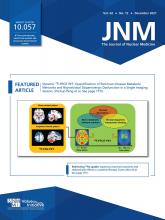Discussions with leaders: JNM associate editor David Mankoff, MD, PhD, talks with Mark Mintun, MD, about molecular imaging advances in academia and industry.
Page 1657
Combination PSMA theranostics: Sandhu and colleagues provide an overview of existing prostate-specific membrane antigen–targeting radionuclide therapies and an update on novel combinatorial approaches under investigation.
Page 1660
Embolization of liver-dominant NETs: Strosberg and colleagues offer perspective on the use of transarterial radioembolization vs transarterial bland hepatic arterial embolization/chemoembolization techniques in liver-dominant metastatic neuroendocrine tumors.
Page 1669
21st century imaging biomarkers: Sellmyer and colleagues discuss the current role of molecular imaging in oncology and highlight therapeutic biomarkers, which can assess whether next-generation drugs reach their target and elicit favorable clinical responses.
Page 1672
PET/MRI axillary lymph node detection: Morawitz and colleagues compare breast MRI, thoracic MRI, thoracic 18F-FDG PET/MRI, and axillary sonography in detection of axillary lymph node metastases in women with newly diagnosed breast cancer.
Page 1677
Interim PET for chemoradiation in NSCLC: Guberina and colleagues report on analysis of a phase 3 trial exploring the prognostic value of postinduction chemotherapy PET in patients with stage III non–small cell lung cancer assigned to receive definitive chemoradiotherapy.
Page 1684
TARE vs. systemic therapy for HCC with MVI: Ahn and colleagues characterize trends for transarterial radioembolization as a first-line treatment for hepatocellular carcinoma patients with macrovascular invasion and compare survival after TARE with that after systemic therapy.
Page 1692
Minimal extrathyroidal PTMC extension: Seifert and colleagues investigate whether minimal extrathyroidal extension is associated with higher aggressiveness (risk of lymph node or distant metastases) in papillary thyroid microcarcinoma.
Page 1702
Bringing VISION to nuclear medicine: Hofman provides a personal perspective on the background, conduct, results, and future implications of the recently published VISION trial of prostate-specific membrane antigen–based radioligand therapy.
Page 1710
Patient-reported symptoms and 177Lu-DOTATATE: Strosberg and colleagues detail symptoms documented by patients with advanced midgut neuroendocrine tumors under 177Lu-DOTATATE treatment in the phase 3 NETTER-1 trial.
Page 1712
Management change after 18F‐rhPSMA‐7.3: Rauscher and colleagues report on the detection efficacy and clinical management impact of this radiohybrid prostate-specific membrane antigen ligand in patients with biochemical recurrence after radical prostatectomy and before salvage therapy.
Page 1719
68Ga-THP PSMA PET/CT in prostate cancer: Afaq and colleagues assess the safety and clinical impact of a novel, kit-based formulation of 68Ga-tris(hydroxypyridinone) prostate-specific membrane antigen for PET/CT in guiding management of patients with prostate cancer.
Page 1727
18F-PSMA-1007 in the prostate gland: Trägårdh and colleagues determine the accuracy of 18F-PSMA-1007 PET/CT for detecting tumors in the prostate gland and explore correlations between tracer uptake, pathology grade, and prostate-specific antigen levels at diagnosis.
Page 1735
PPP criteria and prostate cancer staging: Michalski and colleagues look at the feasibility of recently proposed Prostate-Specific Membrane Antigen PET Progression criteria in a group of patients undergoing PSMA radioligand therapy and discuss their prognostic implications.
Page 1741
PSMA PET–based mHSPC stratification: Barbato and colleagues describe a compatible quantitative prostate-specific membrane antigen PET framework for disease volume assessment in metastatic hormone-sensitive prostate cancer.
Page 1747
Modifying 223Ra distribution: Abou and colleagues investigate the role of enteric ion channels and their modulation for improved therapeutic efficacy and reduced side effects in [223Ra]RaCl2 treatment of bone-metastatic castration-resistant prostate cancer.
Page 1751
Dietary myocardial suppression and cardiac sarcoidosis: Özütemiz and colleagues retrospectively review and compare the efficacy of 3 dietary preparations in achieving myocardial suppression for diagnosis of cardiac sarcoidosis with 18F-FDG PET/CT.
Page 1759
MRI-guided motion-corrected cardiac PET: Munoz and colleagues propose a single cardiac PET/MR image reconstruction framework that fully utilizes MRI-derived information to allow both motion compensation and anatomic guidance within reconstruction.
Page 1768
Dual-phase 18F-FPCIT PET in PD: Peng and colleagues determine whether individual expression of Parkinson disease motor- and cognition-related patterns can be quantified in early-phase images from dynamic 18F-FPCIT PET acquired to assess striatal dopamine transporter binding.
Page 1775
Behavioral neurocognitive disorder: Bastin and colleagues use 18F-FDG PET to research whether patients with the behavioral variant of neurocognitive disorder but less than 3 criteria for the behavioral variant of frontotemporal dementia had characteristic FTD brain metabolic patterns.
Page 1783
PET/MR imaging of CMRO2: Narciso and colleagues introduce a noninvasive reference-based hybrid PET/MRI method using functional MRI to calibrate 15O-O2 PET data, with validation in an animal model and additional development studies.
Page 1789
89Zr-MSLN HLE BiTE: Suurs and colleagues generate a mesothelin-targeted bispecific T-cell engager molecule fused to an Fc-domain for half-life extension and evaluate biodistribution and tumor targeting of a 89Zr-labeled molecule on PET in breast cancer–bearing syngeneic mice.
Page 1797
Patient size–dependent 18F-FDG dosimetry: Carter and colleagues apply newly developed mesh format reference phantoms and a patient-dependent phantom library to assess the impacts of height, weight, and body contour variation on 18F-FDG dosimetry.
Page 1805
Musculoskeletal infection imaging AUC: Palestro and workgroups from SNMMI, the American College of Nuclear Medicine, and the European Association of Nuclear Medicine detail consensus recommendations on appropriate use of nuclear medicine imaging in patients with suspected musculoskeletal infection.
Page 1815
- © 2021 by the Society of Nuclear Medicine and Molecular Imaging.







